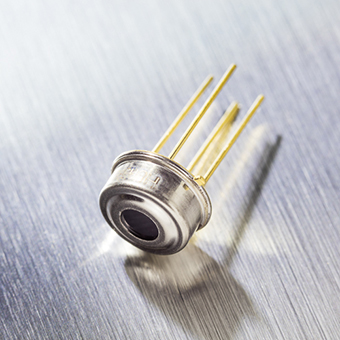Digital Thermometers

Pexels
An era of Digital Thermometer was emerging with its own pace. Suddenly the pandemic changed its course into a 'must have' object in every household, organizations or mass gathering areas.
The image of thermometer that we usually plot in our mind is a probe like device to measure the temperature of an object. It can be placed under your tongue or can be pushed into a loaf of meat to do the job. Probe style thermometers were a standard version to measure temperatures. In recent years several other methods are emerging daily. Among all of them, infrared thermometers are the most exciting and useful style to be considered now a days.
The IR thermometer can be used anywhere anytime to measure the surface temperature of an object.
What is InfraRED?
Red is the colour, and Latin word 'Infra' means below.
Infrared is just one type of radiation that exists within the range of electromagnetic spectrum.
The wavelength of infrared rays is longer than the visible spectrum. If we look into the electromagnetic spectrum it would appear just after the red area of the visible lights spectrum and thus, infrared.
IR radiation is quite literally heat. Our eyes cannot detect infrared visibly but we can feel it. The sizzling fried chicken, the hot cup of tea that we experience with our hands is interaction with infrared radiations.
This IR radiation can be measured and representing that measurement electronically is the basic principle of Handheld digital infrared thermometers.
How Infrared radiation is used to determine temperature?
If there is a difference of temperature between objects, all matter emits energy in the form of Infrared or heat.
If any object in question (OiQ) is at the same temperature with its surroundings the net radiation energy exchange will be zero.
Handheld IR thermometers take this advantage of radiation dependence on temperature and produces a value of the targeted object.
How it works?
Infrared light works like the visible light and can be focused, reflected and absorbed.
IR thermometers typically use a lens to focus light from an object on to a detector.
This sensor or detector is called as Thermopile.
Thermopile absorbs the IR radiation and turns it into heat. The more radiation, the more heat it produces. In a sequence this heat is converted into electrical energy which helps the monitor to measure the electricity. The more radiation means more heat from the thermopile, and more heat means more conversion of energy into millivolts. More millivolts signals the monitor and represented as a temperature reading on the screen.

What is a Thermopile?
Thermopile is the device that converts heat energy into electrical energy.
To be precise, it is a combination of thermocouples arranged in a series or in parallel. When dissimilar metals are exposed to a temperature difference it generates a voltage. This is the basic principal of thermoelectric effect.
A thermopile is just a combination of several thermo-couples which generates a voltage potential.
This is a basic instrument used in meteorology or to measure solar radiations.
Why IR thermometers??
1) Accuracy. This most advanced and accurate method for measuring surface temperatures.
2) Safety. You can measure the temperature of any object from a distance and remotely without touching the object.
3) Prevention of contamination. This remote measuring system can help you to avoid any contamination.
4) Durability. You can carry it anytime anywhere and measure the surface temperature of any object.
5) Mercury free.
6) Reliability
7) Easy to use and pocket friendly.
What are the features you should look into before investing?
1) Broad and bright display with a back light facility.
2) Alert signal and color changing of display to know the higher temperature or fever temperature.
3) Memory, that you can check the last temperatures recorded for tracking.
4) Fast reading.
5) Longer battery life with easy replaceable batteries. and pocket friendly.
6) Distance to Spot ratio.
7) Fahrenheit to Celsius unit conversion and a LASER spotter.
8) Accuracy
9) Safety
10) Light weight and easy to carry and clean.
11) A good array of temperature range. 32℉ - 122℉
12) Lens types and Warranty options.
To be more specific:
Fast reading- The IR thermometer must be fast with its processing to give the accurate results. Ideally it should be less than 3 seconds.
Accuracy- Measuring the accurate surface temperature mostly depends upon the D/S ratio. But the difference of accuracy should be within the range of ± 0.2-0.4℉ .
Distance to Spot ratio- D/S ratio is the size of the area evaluated by the thermometer related to the distance. The smaller the target, the closure you should be to measure the temperature.
This ratio have a significant impact on the accuracy and precision of the reading.
D/S ratio is represented as 30:1 or 5:1 or 8:1 or 12:1 etc.
For an example, if your target size is 4 inches and your thermometer has a D/S ratio of 5:1. Then the maximum distance that you can reliably stand to maintain the safe distance is 20 inches. Means 1' 6".
The larger D/S ratio the accurate measurement you can get for an object or target with its significant size.

How to do the math??? simple. D/S ratio x target size.
Why it is important??? The smaller D/S ratio thermometers will get confused to measure the accurate temperature of an object with its surroundings.
What is the standard D/S ratio? In medical fields a thermometer with a D/S ratio of 12:1 is enough to maintain a safe distance.
Example, to measure the body surface area of 2 inches you can stand 2 feet away from the target surface. This is the main reason to select a thermometer with great range of D/S ratio.
Joke: You do not have to buy the 100:1 D/S ratio thermometer for your medical practice. It only works really well if you are near a volcano.
Types of Digital thermometers
1) Digital forehead thermometers: It is also known as Temporal artery thermometer. It uses the infrared technology to measure the surface temperature of the skin on temporal or forehead areas. Temporal Artery Thermometry was compared with Pulmonary Artery Thermometry (PAT) and it showed 0.1℉ - 0.6℉ accuracy.
2) Digital Ear Thermometer: It is used to measure the body temperature by placing the concerned head inside the ear. Another version of it is also known as behind the ear thermometer.
Digital Ear Thermometer: It is used to measure the body temperature by placing the concerned head inside the ear. Another version of it is also known as behind the ear thermometer.
3) Digital sticks: It is the most common device that we encounter day to day in our life. It can measure the body temperature if placed under the arm.
4) Pacifier thermometer: These are mostly used for infants
5) Oral thermometers
6) Rectal thermometers.
Some best devices available in India
1) Dr. Trust Infrared forehead thermometers

2) Dr. Odin Multifunction infrared thermometer

3) Secureeye Infrared Digital Thermometer

How to verify Infrared Thermometer Accuracy?
The basic concept is an Infrared thermometer can never be as accurate as the probe type thermometers. It can never show 98.6℉ body temperature as it is not measuring the core temperature. It may show within a range from 97.5℉ to 98.3℉.
Some of the methods mention about boiling water test to check the accuracy of an IR thermometer.
Boiling water is not a valid option as the steam may cause damage to the lens.
Instead of boiling water test it is suggested to check your infrared thermometer with Ice water test.
Procedure
> The thermometer must be in room temperature.
> The sensor lens must be free of dust or any debris.
> D/S ratio. If the D/S ratio of your thermometer is 12:1, then you can measure the 1 inch diameter area from 12 inches distance.
> Field view. The IR sensor must be positioned at 90° angle with the target surface to prevent the sensor take the temperature from the surroundings.
> Fill a glass with ice cubes and add enough water just to fill the gaps between the ice. Wait for 2-3 minutes then stir gently for a uniform roll. Point the thermometer at 90° angle at 3" distance and push the button. If the thermometer is accurate it will show 32℉ on screen.
Presented by Arka Bhattacharya
Kolkata
Disclaimer: Online shopping portals do not provide every details of a product. It can be gathered only from the manufacturers. While purchasing go through every details before investing.








No comments:
Post a Comment